Author Archive
How we managed 24 software development trainees
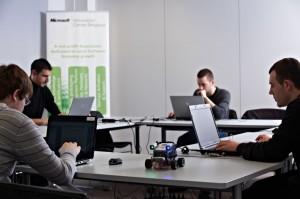
Students programming in main room
Each year the Belgian Microsoft Innovation Center (MIC) runs a program to introduce future graduates in software development to local startup companies. The students come with their enthusiasm and eagerness to learn; the Startups arrive with innovative and exciting projects and the MIC provides the infrastructure and support. This year I had the pleasure to manage 24 students over 19 projects. I’ll explain how we did it.
In addition to the equipment necessary for project implementation (laptops, office, subscriptions, software, etc…) we organized many activities. The purpose of these activities was to increase significantly the level of our future developers’ professionalism while ensuring the proper conduct of the projects for our local businesses. These activities included among others: training, collective code reviews, coaching and each trainee had to give presentations.
Training
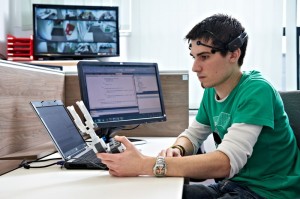
Controlling a claw built with Lego Mindstorms with his mind using Emotiv Headset
There was nothing very special about the training except the emphasis we gave to interactivity. One thing we noticed was that instead of covering new topics we were trying to complete the learning that students had achieved during their studies. Here are some of the topics we covered:
- Coding guidelines
- Source code controllers (We used Mercurial on BitBucket.org)
- Unit Testing
- Design Patterns
- C # in depth (inspired by the book of the same name)
- Agility in general
- Scrum in detail
- Effective Logging & debugging
- Basic concepts of project management software such as backlog management
We believe that these issues need to be fully integrated into university/college curricula. This would allow us to focus on even more advanced subjects.
Collective Code Reviews
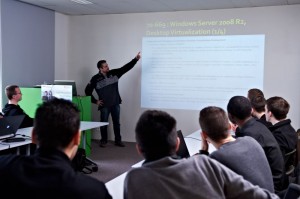
a Collective Code review session
I regularly organized what we call a collective review of the code. This does not mean that everyone read all the code – that would be inefficient.
I read each trainee’s code and when I came across a problem, I would put a screenshot on a powerpoint slide. The next slide was a copy of the previous slide but with arrows showing the errors and a third slide was a screenshot of the code as I would have liked to have seen it. One type of error was added to the presentation once. For example, “poor management of exceptions” was examined only once even if it was a widespread problem found in most projects.
All the students would gather in the conference room to see the presentation. For each problem the first slide is shown so that the group could review it and identify potential problem with the code. Very often, one of the interns suggested the right solution straight away. The slide that highlighted the errors was then displayed and a discussion took place. Finally an example of corrected code was shown (third slide) so that everyone would get the benefit of the “lesson”.
Occasionally, good practice was suggested which always generated discussions and suggestions.
The learning method proved very effective. Students loved the performance aspect since it is very interactive and it always close to the problems they face.
Coaching
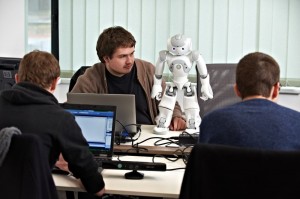
A student programming Nao
In addition to formal learning, intensive coaching has been implemented. At any time, I could intervene to help trainees to advance the project. I was fully dedicated to that during the whole period. They also had the opportunity to come and see me to ask technical questions whenever they could not find a solution online in less than 10 minutes (on Stack Overflow for example). Rather than handing out fish, the technique of coaching was to teach them how to fish. We placed an emphasis on developing the student’s capacity to learn while giving them the ideal conditions for the rapid acquisition of new knowledge. Coaching also included informal learning and covered all the things that are more difficult to cover during presentations to the group. Here are the different subjects which have been covered:
- Continuous integration
- Blogging
- The use of a project tracking tool (we used Trello see below)
- How to write an effective resume
- How to interview
- How to gain certifications (Microsoft ;))
- The attitude to adopt in the business environment
The last point was particularly important to me. Throughout the internship, I stressed the one point that I think will make the difference between them and other developers: the ability to solve problems and not create new ones.
Project Monitoring
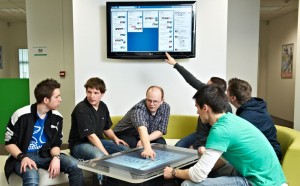
A team using Trello with the Microsoft Surface
Managing the project was a very important part of the project. In fact, following 24 people in 19 projects is not an easy task. We naturally chose to set up Scrum and used a task management tool of the kanban type. Trello was chosen for its ease of use.
We formed four “virtual” teams based on project similarities, included in these “virtual” teams were two real teams of 2 or 3 people, Alongside our desire to maximize the output, we had a secondary objective to get the trainees to live Scrum and agility in general through real scenarios, some exactly as in a large company. So we had the daily scrum, the sprint review, the retrospective and a lighter version of the sprint planning.
Scrum has proven very effective in this type of program. We plan to integrate even more companies in the process. Although I took the role of “Product Owner” on this occasion we think it would bring more if the course tutors played this role, after training.
Trainee presentations
Students had the opportunity to prepare and make presentations to the group of students. These presentations were in addition to what was originally planned in the program and has allowed the students to practice the art of presentation but has also allowed them to share their new learning with the other trainees. Subjects covered were:
- Introduction to HTML5
- MEF (Managed Extensibility Framework)
- Work with Blend interfaces
- Introduction to Windows 8
- Introduction to XNA
- Introduction to ASP.NET MVC
- Deploy a WCF service in Azure
- Object Mocking
- Get organized with GTD
- The pattern MVVM
- Introduction to Programming Kinect
- Which company to choose?
- Introduction to Silverlight
- Debugging with Visual Studio.
We believe that a great developer must learn to communicate his knowledge and this exercise is therefore one of the things we will continue in the future. Indeed, in addition to these presentations, we encourage our trainees to develop a presentation video by making the appropriate equipment available. In business, those who are able to communicate well are often those to whom we entrust the most responsibility.
Conclusion
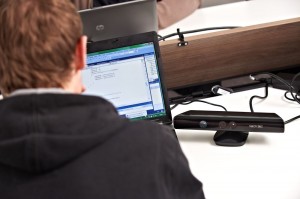
Programming the Kinect for Windows
How will we know if this program will lead to better performance from the students in comparison with other internship models? That’s the question we asked ourselves last year.
This year we have developed a proficiency test that measured several dimensions that we believe a developer must master. As we predicted, the score at the start of the program was pretty bad. At the end of the course this score had, on average, doubled!
Despite this result, we cannot say today that our program will have had an effect significantly superior to another approach, simply because we did not have a control group. We hope to do this in 2013.
I sincerely hope that other companies will be inspired to create a similar program within their specialism. I am also very interested in any form of feedback or to hear of your experiences – you can contact me in the comments.
You can see a video introduction to the program here.
In addition, one of the project participated in the Imagine Cup 2012 and you can watch the video here.
